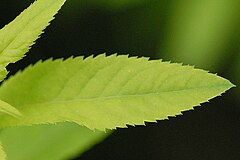Spiraea alba
| Spiraea alba subsp. var. | Meadowsweet | |||||||||||||||||||||||||||||||||||||||||||||||||||||||
|---|---|---|---|---|---|---|---|---|---|---|---|---|---|---|---|---|---|---|---|---|---|---|---|---|---|---|---|---|---|---|---|---|---|---|---|---|---|---|---|---|---|---|---|---|---|---|---|---|---|---|---|---|---|---|---|---|

|
|
| ||||||||||||||||||||||||||||||||||||||||||||||||||||||
| ||||||||||||||||||||||||||||||||||||||||||||||||||||||||
The mountain shrub Spiraea alba is commonly known as narrowleaf meadowsweet, pale bridewort or pipestem and is found in the wet soils of the Allegheny Mountains. [1]
The narrowleaf meadowsweet reaches 8 feet in height. It is often the most conspicuous part of the vegetation in its habitat, taking up large areas of ground. The white flowers grow in spikelike clusters at the top of the plants. The leaves are oblong or lance-shaped and toothed on the edges. The twigs are tough and yellowish brown. The hollow, upright stems were used historically as pipe stems. It flowers from early summer through September.
| Standard Cyclopedia of Horticulture |
|---|
|
Spiraea alba, Dur. (S. salicifolia var. paniculata, Ait. S. lanceolata, Borkh.). Queen Of The Meadow. Meadow-Sweet. Attractive upright shrub, attaining 6 ft., with reddish brown branches puberulous when young: lvs. narrow, oblong to oblanceolate, acute, usually regularly simply serrate, l 1/2 – 2 1/2 in. long: fls. white, in leafy pyramidal tomentulose panicles, the lower spreading ramifications much longer than their supporting lvs.; stamens white, usually as long as petals: follicles quite glabrous. June-Aug. From N. Y. west to Mo., south to Ga. and Miss. B.B. (ed.2)2:245. —Also known as S. salicifolia. CH
|
Cultivation
Propagation
Pests and diseases
Varieties
Gallery
References
- ↑ Venable, Norma Jean (1992), Common Summer Wildflowers of West Virginia, WVU Extension Service.
External links
- w:Spiraea alba. Some of the material on this page may be from Wikipedia, under the Creative Commons license.
- Spiraea alba QR Code (Size 50, 100, 200, 500)
